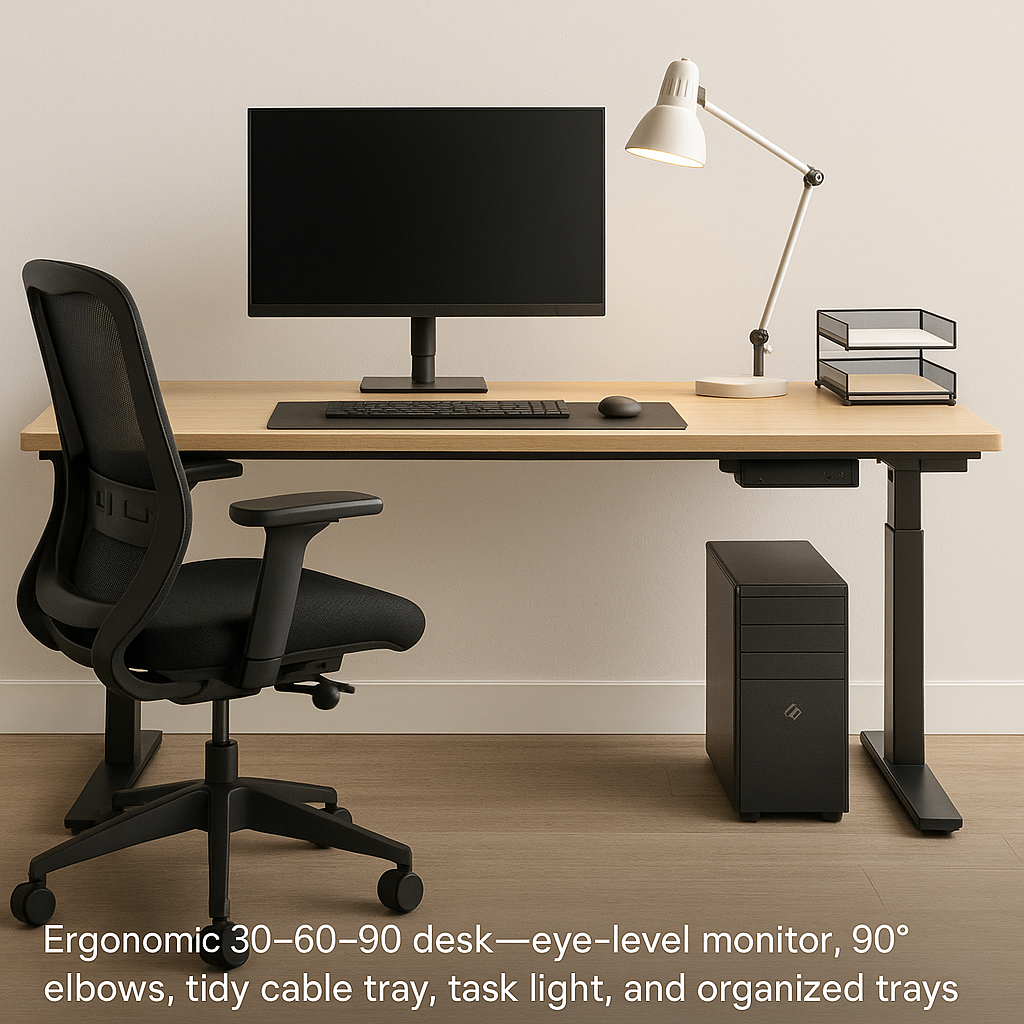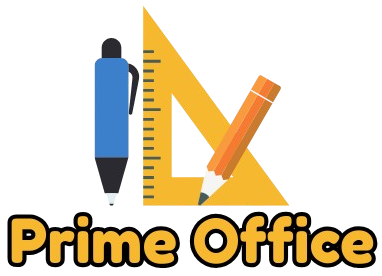
The 30–60–90 Desk: An Ergonomic, Clutter-Free Blueprint for Focused Work | Prime Office Shop
Share
Prologue
A good desk is choreography, not furniture. When ergonomics, power, light, and tools move in concert, attention stops leaking. This blueprint gives you exact distances, angles, and a copy-ready setup plan using essentials from Prime Office Shop—so your station stays quiet, safe, and meeting-ready every day.
1) Fit the Body First (precise ergonomics you can set in 7 minutes)
Chair
-
Seat height: adjust so knees are ~90° and feet flat; add a footrest if heels hover.
-
Seat depth: 2–3 fingers between seat edge and calf.
-
Lumbar: support sits at belt level; tighten until you feel a gentle forward curve.
Desk & Keyboard
-
Elbows: ~90° with forearms parallel; shoulders relaxed.
-
Keyboard tilt: neutral to slight negative (-5° to -10°) to avoid wrist extension.
-
Mouse: same height as keyboard; elbow near torso; consider vertical mouse if forearm strain.
Monitor
-
Top line of text = eye level (±1–2 cm).
-
Distance: 50–75 cm (20–30 in)—about an arm’s length.
-
Dual screens: primary centered; secondary angled 10–20° toward you at equal height.
-
Use a monitor arm or riser for precision without stacks of books.
Standing Option
-
If using a converter/standing desk: elbows 90°, screen up with your eyes; put a mat underfoot; rotate sit:stand ≈ 3:1.
Prime Office Picks: ergonomic chairs, footrests, monitor arms/risers, standing-desk converters, gel wrist rests, anti-fatigue mats.
2) The 30–60–90 Rule (reach zones that prevent clutter)
-
30 cm / 12″ (Core Zone): keyboard, mouse, notebook, phone stand, water.
-
60 cm / 24″ (Active Zone): reference stand, pen cup, sticky notes, calculator.
-
90 cm / 36″ (Staging Zone): in/out trays, labeler, charging dock, tissues, wipes.
Anything beyond 90 cm belongs off the desktop (drawer, wall, or shelf). Use a desk mat to define the Core Zone visually.
Prime Office Picks: desk mats, pen cups, steel letter trays, copy-holders, phone stands.
3) Power That Behaves (quiet, safe, and invisible)
-
Under-desk surge protector or UPS mounted to the rear apron; allow 2–3″ airflow.
-
Cable tray or raceway along underside; short patch cords (1–3 ft) replace extra-long OEM cables.
-
Single wall cord drops through a leg raceway to a flat plug.
-
Label both ends of every cable:
MON_PWR,MON_DP,DOCK_USB-C,ETH. -
No daisy-chain strips. Add a second strip on a separate outlet if needed.
Prime Office Picks: surge protectors, UPS units, cable trays, raceways, Velcro ties, labelers, grommets.
4) Light for Work, Not Glare
-
Task light at ~15–24″ from surface, angled 30–45° away from your dominant hand.
-
Color temperature: 4000K for documents; 3000K evenings to unwind eyes.
-
Place screens perpendicular to windows; add a low-glare desk lamp; keep overheads on a dimmer.
Prime Office Picks: articulated task lamps, warm-dim LED bulbs, clamp lights, bias-light strips for monitors.
5) The Meeting-Ready Drawer (under 60 seconds to present)
Top drawer layout (front → back):
-
Webcam cover & USB-C hub
-
Headset (wired/wireless) with spare tips
-
Microfiber cloth + screen wipes + hand sanitizer
-
Index cards + fine markers for quick agendas
-
Spare batteries & charging cable set labeled
MEET -
Cable ties and adhesive clips for on-the-fly tidy
Prime Office Picks: HD webcams, noise-canceling headsets, wipes, mini whiteboard sets, cable accessories.
6) Paper & Reference Without the Pile
-
One in-tray, one out-tray only; empty daily.
-
Active files live in a desktop step file (max 5 folders).
-
Everything else goes to a rolling file pedestal or wall pocket near the desk.
-
Whiteboard or glass board at eye height for weekly priorities; keep 3 markers (black/blue/green) + eraser on a magnetic cup.
Prime Office Picks: step files, rolling pedestals, wall pockets, whiteboards, magnetic accessories.
7) The 45-Minute Rhythm (maintenance that actually sticks)
Every work block:
-
Minute 0–1: start timer; agenda on one index card.
-
Minute 40–43: stand or stretch; eyes 20-20-20 (look 20 ft away for 20 sec).
-
Minute 43–45: reset desk—return tools to zones, toss notes into in-tray, wipe keyboard/mouse weekly.
Prime Office Picks: visual timers, desk sanitizing kits, posture reminders.
8) Small-Office Network & Print (quiet reliability)
-
Ethernet where possible; if Wi-Fi only, park the router off the floor and away from metal.
-
Printer on a side cart with paper, spare cartridges, and a recycle bin.
-
Duplex printing as default; keep a ream tracker (sticky on the shelf: received/opened/remaining).
Prime Office Picks: printer stands/carts, paper organizers, recycling bins, cable-friendly shelves.
9) The 90-Minute Weekend Makeover (copy-ready)
Minutes 0–20 — Clear & Map
-
Box all loose items. Wipe desk. Sketch your 30–60–90 zones on a sticky; place the desk mat.
Minutes 20–50 — Ergonomics & Light
-
Set chair/desk/monitor by the measurements above. Clamp or place the task light; test glare.
Minutes 50–70 — Power Spine
-
Mount surge/UPS and tray. Route one wall cord in a leg raceway. Label cables.
Minutes 70–85 — Tools & Paper
-
Install in/out trays, step file, pen cup. Hang the whiteboard. Stock the meeting drawer.
Minutes 85–90 — Test & Photograph
-
Sit/stand cycles, webcam check, headphone check. Snap photos of under-desk routing for future reference.
10) Troubleshooting (symptom → cause → fix)
-
Tight neck/shoulders → monitor too low/high → raise/lower so top line of text = eye level.
-
Wrist ache → extension from positive tilt → switch to flat/negative tilt and add a palm rest.
-
Cable mess returns → no tray/labels → add under-desk tray and Velcro; label both ends.
-
Screen glare → lamp/window alignment → rotate screen perpendicular to window, angle task light away from display, add bias light.
-
Paper pile regrows → no exit path → enforce one in-tray, one out-tray; schedule a daily 5-minute clear.
FAQ
Q: Single monitor or dual?
A: If your work is document-heavy, dual at equal height; for creative work, one large display often beats two smaller ones. Use an arm for flexibility.*
Q: Do I need a UPS at home?
A: If you use a desktop, external drives, or an unstable grid, a small line-interactive UPS prevents data loss and spikes.*
Q: Best lamp color temperature?
A: 4000K for daytime clarity; 3000K after dusk. Warm-dim bulbs let you glide between both on one lamp.*
Q: I share a desk with someone taller/shorter.
A: Use a standing-desk converter plus arm-mounted monitors; mark seat height and mat placement with tiny dots under the desk for fast resets.*
Epilogue / CTA
Focus comes from fit + order + quiet power. Build the 30–60–90 Desk with ergonomic chairs, monitor arms, standing-desk converters, task lights, surge/UPS units, cable trays, labelers, file organizers, whiteboards, webcams, headsets, and cleaning kits from Prime Office Shop. Set it once; maintain in minutes.
